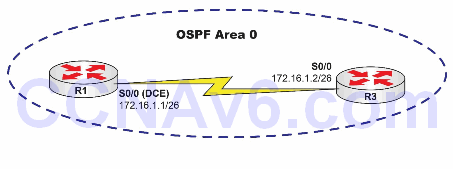Lab Objective:
The objective of this lab exercise is for you to learn and understand how to manually configure the OSPF passive interface. We will repeat the previous lab but then make one of the interfaces passive. This of course will bring down the OSPF connection.
Lab Purpose:
Manually configuring the OSPF passive interface is a fundamental skill.
Certification Level:
This lab is suitable for CCENT certification exam preparation.
Lab Difficulty:
This lab has a difficulty rating of 5/10.
Readiness Assessment:
When you are ready for your certification exam, you should complete this lab in no more than 10 minutes.
Lab Topology:
Please use the following topology to complete this lab exercise:

Task 1:
Configure hostnames on routers R1 and R3 as illustrated in the topology.
Task 2:
Configure R1 S0/0, which is a DCE, to provide a clock rate of 768 Kbps to R3. Configure the IP addresses on the Serial interfaces of R1 and R3 as illustrated in the topology.
Task 3:
Enable OSPF in area 0 between R1 and R3. For R1, use OSPF process ID 1. For R3, use OSPF process ID 3. Verify that your OSPF adjacency has formed between R1 and R3. Make a mental note of the OSPF router ID being used at this time after the adjacency between R1 and R3 has been established.
Task 4:
Manually configure OSPF router ID 1.1.1.1 on R1 and 3.3.3.3 on R3. Reset the OSPF process ID on R1 and R3 by issuing the clear ip ospf process command. Verify that the OSPF adjacency has been re-established between R1 and R3. Verify that the OSPF neighbor IP addresses are now showing as the manually configured router IDs instead of the physical interface IP addresses.
Task 5:
Set S0/0 on R3 as a passive interface.
Configuration and Verification
Task 1:
See previous lab.
Task 2:
See previous lab.
Task 3:
See previous lab.
Task 4:
See previous lab.
R1#show ip ospf neighbor Neighbor ID Pri State Dead Time Address Interface 3.3.3.3 0 FULL/ - 00:00:37 172.16.1.2 Serial0/0 R3#show ip ospf neighbor Neighbor ID Pri State Dead Time Address Interface 1.1.1.1 0 FULL/ - 00:00:39 172.16.1.1 Serial0/0
Task 5
R3#show ip protocols Routing Protocol is “ospf 3” Outgoing update filter list for all interfaces is not set Incoming update filter list for all interfaces is not set Router ID 3.3.3.3 Number of areas in this router is 1. 1 normal 0 stub 0 nssa Maximum path: 4 Routing for Networks: 172.16.1.0 0.0.0.63 area 0 Routing Information Sources: Gateway Distance Last Update 1.1.1.1 110 00:00:10 3.3.3.3 110 00:00:10 172.16.1.2 110 00:00:35 Distance: (default is 110) R3#conf t Enter configuration commands, one per line. End with CTRL/Z. R3(config)#router ospf 3 R3(config-router)#pass R3(config-router)#passive-interface s0/0 R3(config-router)# 00:04:05: %OSPF-5-ADJCHG: Process 3, Nbr 1.1.1.1 on Serial0/0 from FULL to DOWN, Neighbor Down: Interface down or detached R3(config-router)#end R3#show ip prot Routing Protocol is “ospf 3” Outgoing update filter list for all interfaces is not set Incoming update filter list for all interfaces is not set Router ID 3.3.3.3 Number of areas in this router is 1. 1 normal 0 stub 0 nssa Maximum path: 4 Routing for Networks: 172.16.1.0 0.0.0.63 area 0 Passive Interface(s): Serial0/0 Routing Information Sources: Gateway Distance Last Update 1.1.1.1 110 00:00:48 3.3.3.3 110 00:00:05 172.16.1.2 110 00:01:13 Distance: (default is 110)
